
General Electric Company (GE) is an American multinational conglomerate founded in 1892, and incorporated in New York state and headquartered in Boston.
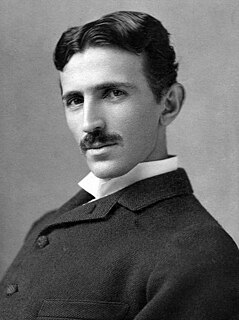
Nikola Tesla was a Serbian-American inventor, electrical engineer, mechanical engineer, and futurist best known for his contributions to the design of the modern alternating current (AC) electricity supply system.

Thomas Alva Edison was an American inventor and businessman. He developed many devices in fields such as electric power generation, mass communication, sound recording, and motion pictures. These inventions, which include the phonograph, the motion picture camera, and early versions of the electric light bulb, have had a widespread impact on the modern industrialized world. He was one of the first inventors to apply the principles of organized science and teamwork to the process of invention, working with many researchers and employees. He established the first industrial research laboratory.

The World's Columbian Exposition was a world's fair held in Chicago in 1893 to celebrate the 400th anniversary of Christopher Columbus' arrival in the New World in 1492. The centerpiece of the Fair, held in Jackson Park, was a large water pool representing the voyage Columbus took to the New World. Chicago had won the right to host the fair over several other cities, including New York City, Washington, D.C., and St. Louis. The exposition was an influential social and cultural event and had a profound effect on American architecture, the arts, American industrial optimism, and Chicago's image.

An incandescent light bulb, incandescent lamp or incandescent light globe is an electric light with a wire filament heated until it glows. The filament is enclosed in a glass bulb with a vacuum or inert gas to protect the filament from oxidation. Current is supplied to the filament by terminals or wires embedded in the glass. A bulb socket provides mechanical support and electrical connections.
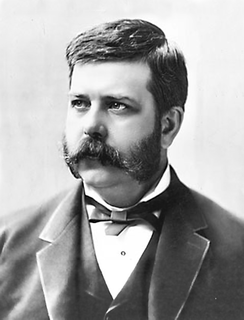
George Westinghouse Jr. was an American entrepreneur and engineer based in Pennsylvania who created the railway air brake and was a pioneer of the electrical industry, receiving his first patent at the age of 19. Westinghouse saw the potential of using alternating current for electric power distribution in the early 1880s and put all his resources into developing and marketing it. This put Westinghouse's business in direct competition with Thomas Edison, who marketed direct current for electric power distribution. In 1911 Westinghouse received the American Institute of Electrical Engineers's (AIEE) Edison Medal "For meritorious achievement in connection with the development of the alternating current system."
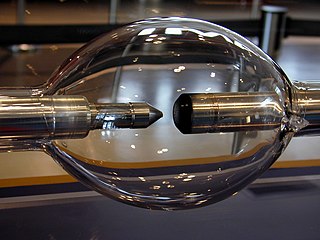
An arc lamp or arc light is a lamp that produces light by an electric arc.

The 1964–1965 New York World's Fair was a world's fair that held over 140 pavilions and 110 restaurants, representing 80 nations, 24 US states, and over 45 corporations with the goal and the final result of building exhibits or attractions at Flushing Meadows–Corona Park in Queens, New York City. The immense fair covered 646 acres (2.61 km2) on half the park, with numerous pools or fountains, and an amusement park with rides near the lake. However, the fair did not receive official support or approval from the Bureau of International Expositions (BIE).
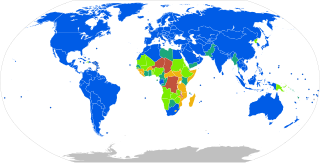
Mains electricity or utility power, power grid, domestic power, and wall power, or in some parts of Canada as hydro, is a general-purpose alternating-current (AC) electric power supply. It is the form of electrical power that is delivered to homes and businesses through the electric grid in many parts of the world. People use this electricity to power everyday items—such as domestic appliances, televisions and lamps—by plugging them into a wall outlet.
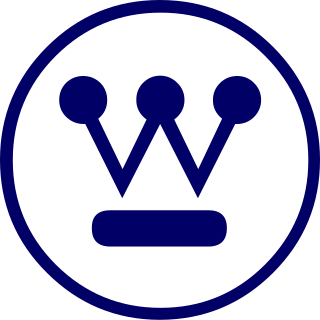
The Westinghouse Electric Corporation was an American manufacturing company founded in 1886 by George Westinghouse. It was originally named "Westinghouse Electric & Manufacturing Company", and was renamed "Westinghouse Electric Corporation" in 1945. The company acquired the CBS television network in 1995, and was renamed "CBS Corporation", until being acquired by Viacom in 1999. That merger was completed on April 26, 2000. The CBS Corporation name was later reused for one of the two companies resulting from the split of Viacom in 2006.

The UL enterprise is a global safety science company headquartered in Northbrook, Illinois, composed of three organizations, UL Research Institutes, UL Standards & Engagement and UL Solutions.

Walt Disney's Carousel of Progress is a rotating theater audio-animatronic stage show attraction that is located in Tomorrowland at the Magic Kingdom theme park at the Walt Disney World Resort in Bay Lake, Florida just outside of Orlando, Florida. Created by both Walt Disney and WED Enterprises as the prime feature of the General Electric (GE) Pavilion for the 1964 New York World's Fair, the attraction was moved to Tomorrowland at Disneyland in Anaheim, California as Carousel of Progress, remaining there from 1967 until 1973. It was replaced in Disneyland by America Sings in 1974, and reopened in its present home in the Magic Kingdom in 1975.

Tilling-Stevens was a British manufacturer of buses and other commercial vehicles, based in Maidstone, Kent. Originally established in 1897, it became a specialist in petrol-electric vehicles. It continued as an independent manufacturer until 1950, when it was acquired by the Rootes Group.
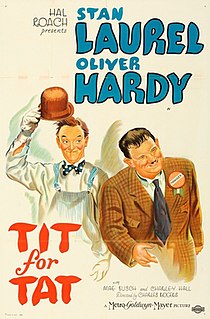
Tit for Tat is a 1935 short comedy film starring Stan Laurel and Oliver Hardy. It is the only direct sequel they made, following the story of Them Thar Hills, which was released the previous year and includes the same two supporting characters, Mr. and Mrs. Hall, portrayed by Charlie Hall and Mae Busch. This "two-reeler" is notable too for being nominated for an Academy Award as Best Live Action Short Film (Comedy) of 1935, although it did not win. It also has a central theme similar to the comedy duo's 1929 silent short Big Business. In the opening scene of Tit for Tat, Oliver places a sign in the front window of his and Stan's electrical store. It reads "Open for Big Business", an allusion to the escalating revenge and "reciprocal destruction" common to both films.
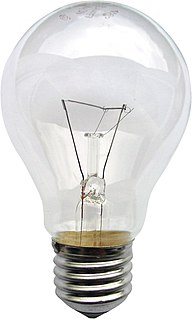
Edison screw (ES) is a standard lightbulb socket for electric light bulbs. It was developed by Thomas Edison (1847–1931), patented in 1881, and was licensed in 1909 under General Electric's Mazda trademark. The bulbs have right-hand threaded metal bases (caps) which screw into matching threaded sockets. For bulbs powered by AC current, the thread is generally connected to neutral and the contact on the bottom tip of the base is connected to the "live" phase.

Schuyler Skaats Wheeler was an American electrical engineer and manufacturer who invented the electric fan, an electric elevator design, and the electric fire engine. He is associated with the early development of the electric motor industry, especially to do with training the blind in this industry for gainful employment. He helped develop and implement a code of ethics for electrical engineers and was associated with the electrical field in one way or another for over thirty years.

The global atmospheric electrical circuit is the continuous movement of atmospheric electricity between the ionosphere and the Earth. Through the balance of thunderstorms and fair weather, the atmosphere is subject to a continual and substantial electrical current.

Walter D'Arcy Ryan was an influential early lighting engineer who worked for General Electric as director of its Illuminating Engineering Laboratory. He pioneered skyscraper illumination, designed the Scintillator colored searchlights display, and was responsible for the lighting of the Panama-Pacific International Exposition in San Francisco and the Century of Progress Exposition in Chicago, in addition to the first complete illumination of Niagara Falls. He combined illumination into both an art and a science.

Sidney Howe Short was an electrical engineer, inventor, physicist, professor and businessman. He is known for the development of electric motors and electric railway equipment. His inventions were so successful that even his competitors dubbed him "The Trolley King". He also developed telephone equipment much like that of Alexander Graham Bell. As a businessman he was president, key engineer, or advisor of different companies related to electrical equipment. It is claimed that he had nearly as many electrical innovations as Thomas Edison.

Maysie Chalmers, also known as Mrs Pender Chalmers, was a British electrical engineer and designer, and an aviator who competed in flying races, after an early career as an actress. In the 1920s and 1930s, she was a leading figure in the Electrical Association for Women, serving as vice chairman. In 1936, she became the first art adviser in electrical lighting to be appointed in the United Kingdom. She was known as Mrs Frank Forrest after remarrying in 1937.



















